Importance Of Attendance At Work | 10+ Ways to Improve Employees Attendance

One primary importance of attendance at work lies in fostering trust and accountability.
A dependable workforce ensures that projects progress smoothly, deadlines are met, and a culture of reliability prevails.
Employers benefit from enhanced team collaboration, while employees experience heightened job security and accomplishment.
Addressing attendance challenges head-on, employee attendance tracking software emerges as a transformative solution.
Top three issues that attendance tracking software solves:
Fair and Systematic Tracking: Employee attendance tracking software ensures fair and systematic recording of attendance data, offering a baseline for understanding and addressing absenteeism consistently across the workforce.
Clear Communication and Expectations: The software facilitates transparent communication and the establishment of clear attendance expectations.
Streamlining protocols and policies creates a shared understanding of workplace culture, minimizing absenteeism due to misunderstandings.
Efficient Absence Management: Attendance tracking tools enables efficient management of employee absences, allowing supervisors to engage with staff during and after periods of absence empathetically.
Try Buddy Punch For Free
What Is The Purpose Of Employee Attendance?
The purpose of employee attendance is to create a cohesive and efficient work environment where teams can collaborate seamlessly, projects can progress without hindrance, and organizational goals are consistently met.
It fosters a culture of trust among team members and cultivates a sense of responsibility, which is essential for any business’s sustained growth and success.
| Why Is Employee Attendance Important At Work? |
| Employee attendance is important in the seamless functioning and success of any workplace. Beyond the evident need for a full staff complement, attendance demonstrates commitment and reliability. A consistent attendance record ensures the smooth execution of tasks, meeting deadlines, and fostering a collaborative environment. Moreover, it is pivotal in shaping organizational culture and reinforcing a sense of responsibility and accountability. |
Crucial Factors That Affect Employee Attendance At Work
Following are some of the factors that affect employee attendance at work.
1. Health Issues
Physical and mental well-being significantly impact an individual’s ability to maintain consistent attendance.
Health issues, ranging from common illnesses to more complex conditions, can lead to absenteeism and decreased productivity.
Understanding the importance of employees’ health is vital for organizations aiming to improve attendance.
Implementing wellness programs, fostering a supportive environment, and providing access to healthcare resources are crucial.
2. Work-Life Balance
When the scales tip unfavorably, employees may face burnout, stress, and fatigue, leading to increased absenteeism.

Striking the right equilibrium between professional responsibilities and personal well-being is essential for sustained attendance and productivity.
Organizations that prioritize and support work-life balance cultivate a positive workplace culture, fostering employee satisfaction and engagement.
Addressing and promoting a harmonious work-life balance is key to ensuring employees meet professional commitments without compromising their overall well-being.
3. Commute Challenges
Lengthy or challenging commutes can contribute to stress and fatigue, potentially leading to tardiness or increased absenteeism.
In today’s world, where remote work is increasingly prevalent, addressing commute challenges becomes crucial for organizations seeking to enhance attendance.
Employers can explore flexible work arrangements, remote work options, or alternative transportation solutions to alleviate the strain of commuting.
Recognizing and mitigating commute-related obstacles contribute to a more accommodating workplace, promoting employee attendance and overall job satisfaction.
3. Job Satisfaction and Engagement
A content and engaged workforce is likelier to demonstrate commitment and regular attendance.
When employees find meaning and fulfillment in their roles, it contributes to a positive workplace culture, reducing the likelihood of absenteeism.
Employers can foster job satisfaction by providing opportunities for skill development, recognizing achievements, and promoting a supportive work environment.
4. Workload and Stress
An overwhelming workload and excessive stress can lead to burnout, absenteeism, and a decline in overall productivity.
As employees grapple with heavy work demands, it becomes imperative for organizations to implement strategies that manage workload effectively and promote stress resilience.
Encouraging breaks, setting realistic goals, and fostering a supportive work environment are essential steps in mitigating the impact of workload and stress on attendance.
5. Negative Work Environment
Hostile workplace cultures, ineffective leadership, and poor interpersonal dynamics increase absenteeism.
Employees are more likely to be present when they feel supported or valued.
To improve attendance, organizations must prioritize creating a positive work environment that promotes collaboration, open communication, and a sense of belonging.
Cultivating a culture of respect and appreciation can counteract the detrimental effects of a negative workplace, ultimately enhancing attendance and overall employee well-being.
Common Methods To Track Employee Attendance At Work
Following are some of the common methods businesses use to track employee attendance at work.
1. Manual Tracking
Manual tracking methods have been a traditional approach for employers.
However, relying on manual tracking, such as paper timesheets or physical clocking systems, poses several challenges.

Manual methods are prone to errors, leading to inaccuracies in recording employee attendance.
Managers often need help overseeing overtime, ensuring compliance with labor laws, and managing payroll efficiently.
Moreover, the risk of buddy punching remains prevalent, where one employee clocks in for another.
Organizations are increasingly turning to automated solutions for attendance tracking in the modern workplace.
These solutions not only eliminate the drawbacks of manual tracking but also offer enhanced accuracy, real-time insights, and streamlined processes, contributing to improved workforce management and overall operational efficiency.
2. Timesheets
Timesheets have long been a conventional method for tracking employee attendance at work.
This manual approach involves recording the hours worked by each employee, typically on a weekly or bi-weekly basis.

While timesheets offer a tangible attendance record, they come with inherent challenges.
Accuracy issues, intentional or unintentional time manipulation, and the cumbersome manual data entry process contribute to potential errors.
As organizations strive for greater efficiency and accuracy in attendance tracking, many are transitioning to automated timesheet solutions.
These modern timesheet tools mitigate the pitfalls associated with timesheets and offer features like real-time tracking, instant reporting, and integration with other HR processes, ultimately fostering a more streamlined and error-resistant approach to employee attendance management.
3. Keycards
Keycards represent a widely adopted method for tracking employee attendance at work.
In this system, employees use electronic keycards or badges to clock in and out, streamlining the process and minimizing queues during entry and exit.
While keycards offer the advantage of quick and efficient attendance recording, they are not without drawbacks.
Issues such as card loss or forgetfulness may lead to manual clock-ins, potentially compromising accuracy.
Despite this, keycards remain popular due to their speed and ease of use.
Advanced systems often incorporate features like photo verification and unique passcodes to combat buddy punching.
With real-time data tracking, managers can gain insights into attendance patterns promptly.
4. Time Tracking Software
Time tracking software has emerged as a tool for efficiently monitoring and improving employee attendance at work.

Time tracking tools offer a digital solution that surpasses traditional manual tracking or paper timesheets.
With time tracking software, employees can easily clock in and out, and managers gain real-time visibility into attendance patterns.
One notable advantage is the accuracy and automation it brings to attendance records, reducing the risk of errors associated with manual methods.
These systems often come equipped with features such as GPS and photo verification, mitigating concerns like buddy punching and ensuring the right person is in the right place at the right time.
5. Biometrics
Leveraging unique physiological traits such as fingerprints, facial recognition, or even iris scans, biometric systems offer a high level of accuracy and eliminate concerns related to buddy punching or fraudulent timekeeping.

Implementing biometrics enhances workplace security by ensuring only authorized personnel can access specific areas or clock in for work.
The biometrics technology adds an extra layer of accountability, as each attendance entry is directly linked to a specific individual, leaving no room for impersonation.
Moreover, biometric systems streamline attendance tracking, reducing administrative burdens associated with manual methods.
What Are The Best Ways To Improve Employee Attendance?
The following are some of the ways to improve employee attendance.
1. Tracking Attendance
Implementing robust attendance tracking systems, such as time tracking software or biometric solutions, gives organizations real-time insights into employee attendance patterns.
By leveraging advanced technology, employers can automate attendance monitoring, minimize errors, and discourage tardiness or absenteeism.
These systems offer comprehensive data, enabling managers to promptly identify attendance trends, address issues, and recognize employees who consistently uphold punctuality standards.
Beyond traditional methods, modern attendance tracking apps contribute to a positive work culture by fostering transparency and trust.
Try Buddy Punch For Free
2. Flexible Work Options
Recognizing the evolving dynamics of the workplace, organizations are increasingly adopting flexible arrangements, such as remote work or alternative schedules, to accommodate diverse employee needs.
Flexible work options empower employees to balance personal and professional commitments, reducing the likelihood of unplanned absenteeism.
Organizations foster a sense of trust and responsibility among their workforce by providing autonomy over work hours or remote work capabilities.
This approach acknowledges that employees have varied circumstances and responsibilities outside the workplace.
Consequently, offering flexibility improves attendance and contributes to higher job satisfaction and overall employee well-being.
3. Employee Recognition and Incentives
Establishing a robust recognition program that highlights and rewards consistent attendance creates a positive and encouraging work environment.
Recognition can take various forms, from public acknowledgments to personalized commendations, fostering a sense of pride and accomplishment among employees.
In addition to recognition, implementing well-designed incentives motivates employees to prioritize attendance.
These incentives could include bonuses, extra time off, or other tangible rewards for maintaining a commendable attendance record.
4. Wellness Programs
Wellness programs programs go beyond traditional healthcare benefits by addressing holistic well-being, encompassing physical, mental, and emotional health.
Wellness initiatives can include fitness programs, mental health support, nutritional guidance, and stress management resources.
By promoting a healthy work-life balance, these programs contribute to reducing absenteeism and fostering a more vibrant and engaged workforce.
Moreover, wellness programs signal a company’s commitment to the health and happiness of its employees, creating a positive workplace culture.
Employees who feel supported in their well-being are more likely to prioritize attendance and contribute to a more productive and positive work environment.
5. Effective Communication
Clear and transparent communication channels foster a sense of belonging and keep employees informed about the organization’s expectations, policies, and changes.
Establishing regular channels for communication, such as team meetings, newsletters, and digital platforms, ensures that employees are well-informed about attendance policies, upcoming events, and any schedule adjustments.
Open communication also provides a platform for employees to voice concerns or seek clarification, reducing the likelihood of absenteeism due to misunderstandings.
Moreover, creating a positive and supportive communication culture encourages employees to feel valued and connected to their work.
When individuals understand their presence’s impact on the team’s overall success, they are more likely to prioritize attendance and actively contribute to the organization’s goals.
6. Work-Life Balance Support
Employees who feel supported in managing their personal and professional lives likely exhibit higher morale, engagement, and improved attendance.
Acknowledging employees’ diverse needs and responsibilities outside the workplace is fundamental to fostering a healthy work-life equilibrium.
Organizations can implement policies that facilitate flexible work hours, remote options, and compressed work weeks.
These measures empower employees to manage personal commitments better while fulfilling professional responsibilities.
Promoting a culture that respects downtime, encourages breaks, and discourages excessive overtime also contributes to a more balanced and sustainable work environment.
7. Employee Assistance Programs
Employee Assistance Programs (EAPs) are comprehensive initiatives designed to support employees in managing personal challenges that may impact their work performance.
These programs typically offer confidential counseling, mental health services, and resources to address issues such as stress, anxiety, and work-life balance.
By providing a supportive framework, organizations create an environment where employees feel comfortable seeking assistance for personal challenges that may contribute to absenteeism.
EAPs not only contribute to employees’ mental and emotional well-being but also address potential underlying factors that could lead to attendance issues.
Offering a range of services, from counseling to financial assistance, EAPs demonstrate a commitment to the holistic health of the workforce.
8. Flexible Leave Policies
By embracing flexible leave options such as sick leave, time management, and absence policy, organizations foster a supportive environment that considers the diverse needs of their workforce.
Offering choices like remote work, compressed workweeks, and unlimited paid time off encourages a healthy work-life balance.
Having this approach empowers employees to proactively handle their schedules, minimizing the risk of unexcused absences and reinforcing a trust-based relationship between employers and their teams.
A well-defined employee handbook further guides staff on family member notifications and workplace attendance expectations.
Following this holistic approach not only addresses individual needs but also enhances employee engagement, contributing positively to overall morale and productivity.
Organizations that value the well-being of their employees create a culture where attendance becomes a natural priority, showcasing the significance of work-life harmony.
9. Regular Check-Ins
Implementing routine one-on-one meetings between managers and team members creates a supportive environment where concerns can be addressed, feedback exchanged, and goals aligned.
These check-ins provide an opportunity to discuss any challenges employees may face, allowing managers to offer support and resources proactively.
By understanding individual needs and addressing potential issues promptly, managers can contribute to a positive work experience, boosting attendance.
Moreover, regular check-ins facilitate open communication, helping to identify and resolve issues before they escalate.
10. Clear Attendance Policies
By articulating expectations regarding punctuality, time-off requests, and consequences for non-compliance, these attendance policies provide a transparent framework for both employees and management.

Well-defined attendance policies help set the standard for professional conduct, reducing ambiguity and promoting fairness across the organization.
Employees are more likely to prioritize attendance when they understand the expectations and consequences associated with absenteeism.
To enhance the effectiveness of clear attendance policies, organizations should communicate them regularly, offer resources for clarification, and encourage feedback.
Companies can positively impact attendance by establishing and consistently reinforcing these policies while promoting a cohesive and respectful workplace culture.
11. Find Reliable Transportation
Transportation challenges can be a significant barrier to punctuality and consistent attendance.
Companies can proactively address this issue by exploring transportation options or providing resources to help employees overcome commuting obstacles.
Implementing shuttle services, carpooling initiatives, or partnerships with ride-sharing services are effective ways to enhance transportation accessibility.
Understanding the unique commuting needs of employees and tailoring solutions to those needs can make a substantial difference.
Additionally, flexible work arrangements, such as remote work options or adjusted schedules, can alleviate transportation challenges for certain roles.
By offering alternative work arrangements, companies enhance attendance and demonstrate a commitment to supporting their employees’ work-life balance.
Buddy Punch | Best Work Attendance Tracking Software
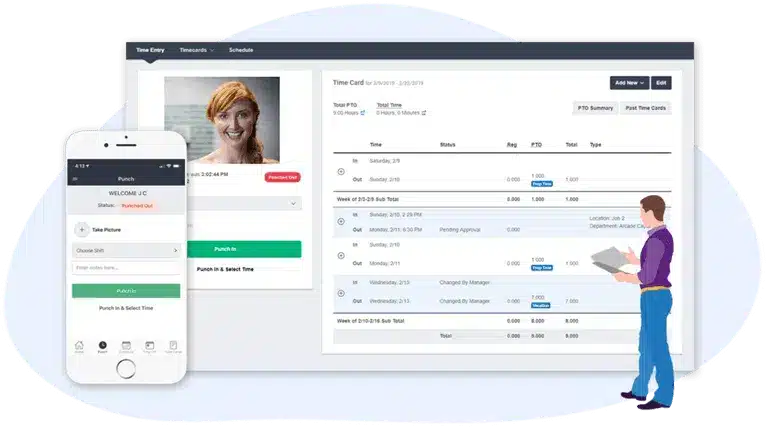
Buddy Punch is a leading attendance tracking software offering employers a comprehensive solution to manage and streamline employee attendance.
Its user-friendly interface and robust features make it the go-to choice for many organizations.
With Buddy Punch, employers can track working hours, monitor attendance patterns, and generate accurate timesheets.
The software’s versatility allows employees to clock in and out from various devices, promoting flexibility in time tracking.
Advanced features, such as geofencing and photo verification, enhance accuracy and prevent time fraud.
Buddy Punch also simplifies payroll processing by providing precise data, minimizing errors associated with manual timekeeping.
Moreover, the cloud-based nature of Buddy Punch ensures accessibility from anywhere, facilitating remote workforce management.
The software’s reporting tools enable employers to analyze attendance trends, supporting informed decision-making for staffing and scheduling.
1. Real-Time Attendance Tracking
With its advanced features, Buddy Punch ensures that businesses can seamlessly monitor employee attendance, time-off requests, and overtime in the present moment.
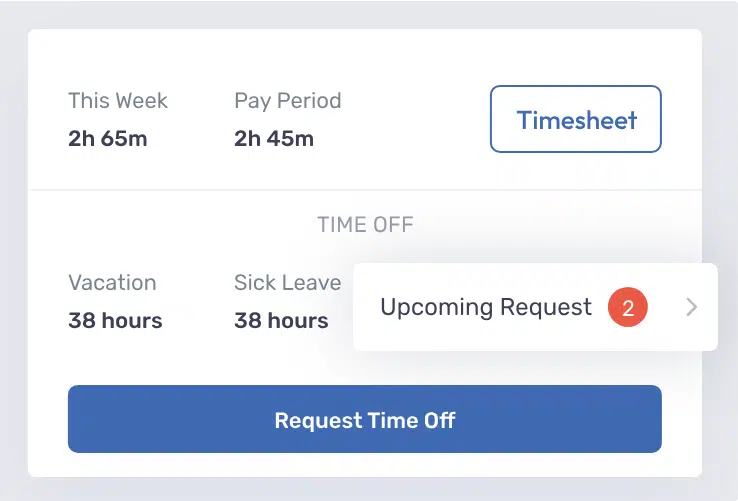
The real-time insights provided by Buddy Punch empower managers to make informed decisions, allowing them to stay ahead of scheduling requirements and potential issues.
This feature-rich software employs various methods such as GPS and webcam images to maintain accountability, preventing discrepancies in attendance records.
2. Track Employees Location
Among Buddy Punch’s notable capabilities is tracking employees’ locations in real time.
The feature leverages GPS technology, providing employers with a comprehensive view of where their staff is during work hours.
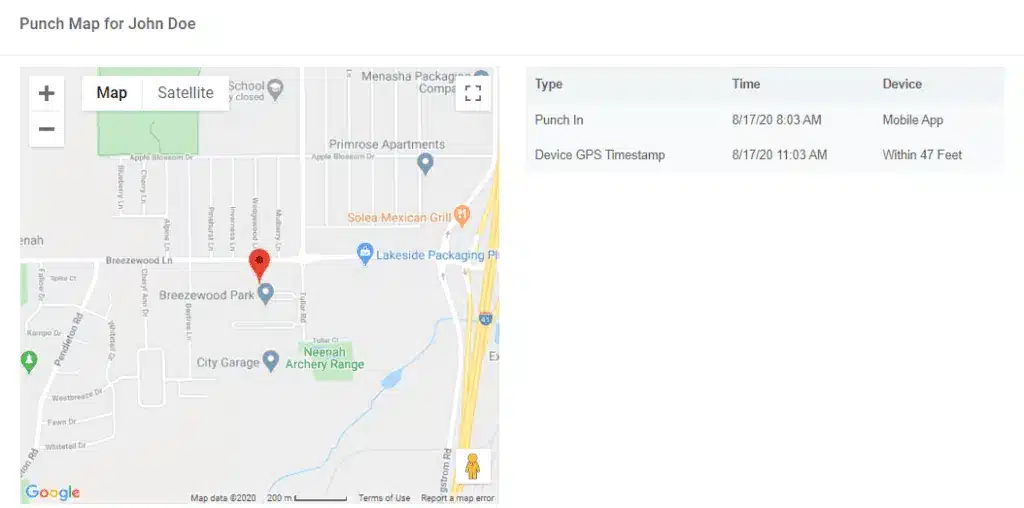
By incorporating location tracking, Buddy Punch enhances accountability and ensures that employees are where they need to be at any given time.
The feature not only aids in preventing time theft but also fosters a culture of transparency and trust within the workplace.
3. Time-Off Tracking
Buddy Punch excels in monitoring employees’ work hours and efficient time-off tracking.
The platform offers a robust system for managing and recording various types of leave, including paid time off (PTO), sick days, and vacations.

With Buddy Punch’s time-off tracking feature, employers can handle employee leave requests, approvals, and accruals effortlessly.
The built-in calendar simplifies requesting time off, providing a user-friendly interface for employees to submit requests.
This functionality ensures accurate record-keeping and promotes transparency and communication between employees and management.
4. Flexible Punch Options
The flexibility in punch options enhances user convenience and adaptability, accommodating various work environments and preferences.

This ensures that employees can seamlessly clock in and out using the most convenient method, contributing to a smoother attendance tracking experience.
5. Workflow Management
The workflow management feature ensures a streamlined process for reviewing, approving, and managing attendance records.
This includes customizable email and mobile app alerts (on both iOS and Android), allowing managers to stay informed and take prompt actions.
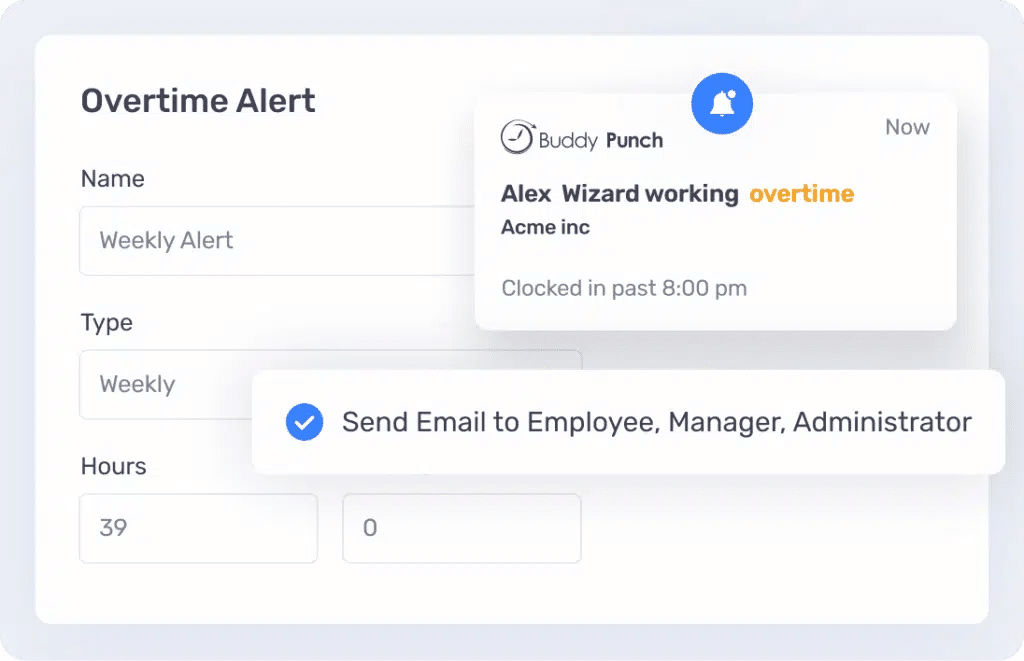
Whether approving time-off requests, managing work hours, or handling various aspects of attendance, Buddy Punch’s workflow management feature brings heightened organization and control to the time tracking process.
6. Overtime Calculations
Buddy Punch’s overtime calculations feature is valuable for businesses striving for precision in time related matters.

It reinforces its position as the go-to attendance tracking software for those aiming to enhance operational efficiency and compliance.
This feature offers over a dozen overtime types, including options tailored to various workweek structures, such as 40-hour Work Weeks, California Overtime, and more.
Customizable rules ensure accurate overtime calculations, accommodating the diverse needs of businesses.
With real-time insights into employees’ hours, managers can set up alerts for nearing daily or weekly overtime thresholds, allowing for proactive schedule adjustments.
This ensures compliance with labor regulations and aids in budgeting and resource allocation.
7. PTO/Vacation Management
Administrators and managers can seamlessly handle PTO requests and approvals through Buddy Punch’s built-in calendar, providing employees with a user-friendly platform to request time off.
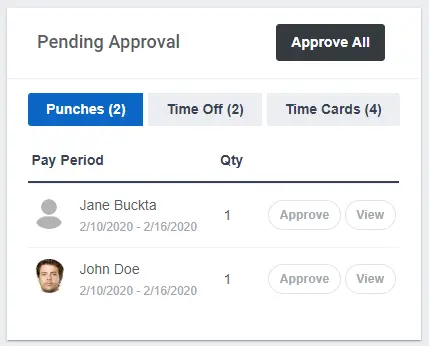
The system supports paid and unpaid time off, offering flexibility to cater to diverse leave policies.
The software enables easy tracking of accrued PTO balances, allowing employees to view their totals and availability.
This transparent approach ensures that employees and management are on the same page regarding leave balances, fostering a smoother and more organized workflow.
8. Webcam Feature
With the webcam feature, administrators and managers can verify attendance by visually confirming the employee’s identity at the moment of each punch.
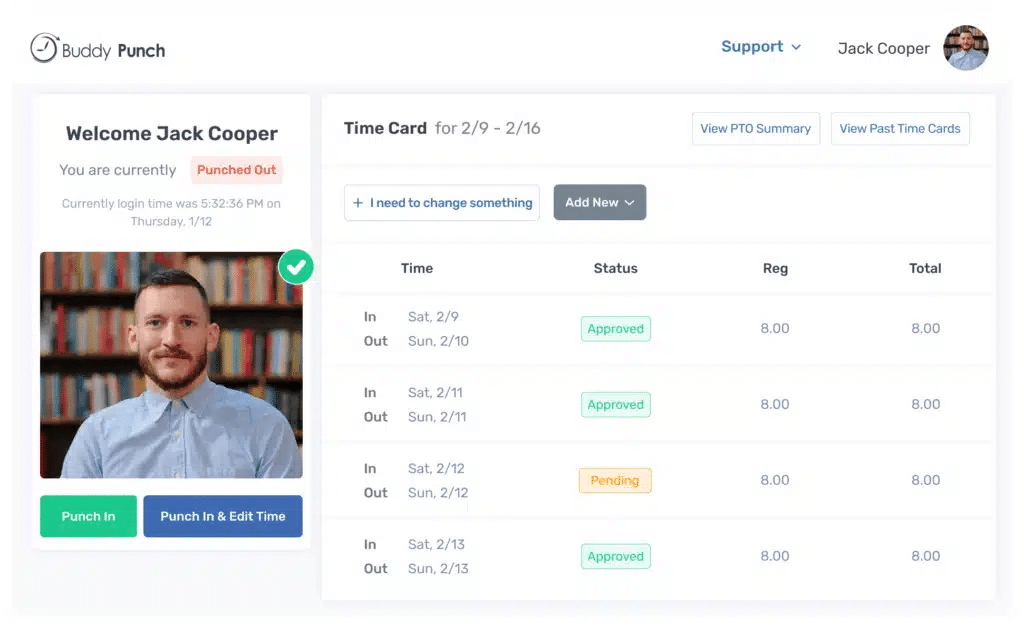
This enhances security and provides tangible proof of the employee’s presence, fostering a culture of honesty and reliability.
The real-time webcam images, coupled with GPS data, offer comprehensive insights into employees’ work locations.
This dual-layered approach ensures that businesses can maintain a vigilant eye on attendance, track employee movements, and address any discrepancies promptly.
9. Different Integration Options
With integration options, including QuickBooks, Paychex, ADP, and more, Buddy Punch adapts to the unique needs of businesses.

This interoperability streamlines processes by syncing employee information and time data on demand.
If your preferred integration is missing from the list, Buddy Punch remains open to customization, exemplifying its commitment to meeting diverse business requirements.
Whether you rely on QuickBooks Online, QuickBooks Desktop, or other platforms, Buddy Punch empowers you to incorporate attendance data into your existing systems effortlessly.
This not only enhances workflow efficiency but also minimizes manual input, reducing the likelihood of errors in time tracking and payroll processes.
10. Text To Punch Option
The text to punch option allows employees to send a simple text message to initiate clocking in or out, eliminating the need for a dedicated app.
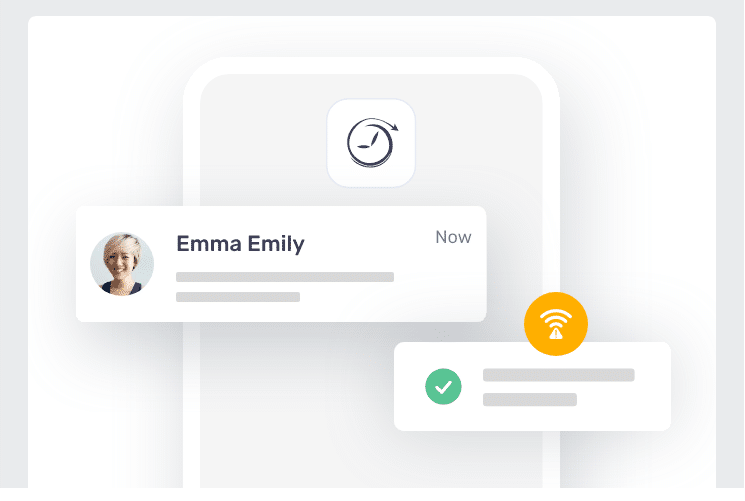
This feature ensures that even individuals without a constant internet connection can record their work hours effortlessly.
Employees can securely and conveniently manage their attendance by leveraging SMS messaging, fostering a seamless and inclusive time tracking approach.
This user-friendly and accessible text to punch option exemplifies Buddy Punch’s commitment to providing versatile solutions accommodating diverse work scenarios.
Whether employees are on the go or in remote locations, this feature ensures they get all the punch, contributing to more accurate and efficient attendance management.
Buddy Punch’s Online Reviews
As of writing this blog post, Buddy Punch has a total of 925 total reviews with an average rating of 4.8 out of 5 on capterra.

“Great app, check in and out with accuracy, keep in contact with supervisors and can submit photos for proof of visit if not using GPS.”
Click here to read the full review.
“Delighted! As a trucking company and having resources starting their shifts at different times and in different locations it was “effort” in tying this all together to ensure everyone was being paid for correct times – doing payroll was a chore in calling and requesting and then finally imposing deadlines or you don’t get paid which pushes other things back in processing payroll… Week one of deployment -> all those issues disappeared!!! Well done Buddy Punch!!!!”
Click here to read the full review.
“We will always use buddy punch, It works for Us.”
Click here to read the full review.
Try Buddy Punch for Free
Ready to start a free trial?
No credit card required, all features included.
If you feel that Buddy Punch might be the right fit for your business, sign up for a 14-day free trial (no credit card needed). You can also book a one-on-one demo, or view a pre-recorded demo video.
What Are The Key Benefits Of Good Employee Attendance?
The following are the key benefits of good employee attendance.
1. Enhanced Productivity
Ensuring that employees are consistently present and adhere to their work schedules is crucial for small businesses looking to maximize employee productivity.

Small businesses often face challenges related to lost productivity, especially when dealing with absent employee attendance matters.
Timely and accurate time cards play a pivotal role in addressing these concerns, as they streamline the tracking of working hours, making the process less time-consuming for both employers and employees.
You can use a time management tool for that matter.
Time management apps are essential for small businesses to mitigate the impact of lost productivity.
When employees prioritize punctuality and commit to their work schedules, it not only reduces downtime but also fosters a sense of responsibility.
This commitment leads to increased engagement, allowing the team to meet deadlines and contribute collectively to organizational success.
In this context, small businesses can benefit from implementing efficient time-tracking systems to manage attendance matters and enhance overall operational efficiency.
2. Increase Team Morale
Consistent and punctual attendance fosters a positive work environment, enhancing employee morale and contributing to the collective success of the organization.

This commitment to the workday not only strengthens mutual reliance among team members but also minimizes disruptions, promoting smoother workflow and project execution.
In turn, maintaining high attendance rates positively impacts human resources by reducing stress and creating a harmonious workplace, ultimately mitigating the need for disciplinary action.
3. Meet Meeting Deadlines
When employees consistently attend work, teams are adequately staffed, enhancing project timelines’ efficiency and effectively meeting deadlines.
A reliable and punctual workforce contributes to seamless project coordination, reducing the risk of delays and bottlenecks in the workflow.
With all team members present and actively participating, collaboration becomes more effective, enabling teams to address challenges promptly and allocate tasks efficiently.
The results is a streamlined process that aligns with project timelines, ensuring that deadlines are met consistently.
4. Employee Development
When employees consistently attend work, they create a stable foundation for their professional growth.
Regular attendance allows individuals to actively engage in training sessions, workshops, and skill-building activities, fostering continuous learning and development.
Employees can participate in developmental programs without disruption in a workplace where attendance is valued, ensuring they acquire new skills and knowledge.
Their commitment to attendance reflects a dedication to personal and professional advancement.
It enables employees to stay updated with industry trends, enhance their competencies, and contribute more effectively to the organization’s success.
Moreover, good attendance is a testament to an employee’s commitment to their development and career progression.
Employers are more inclined to invest in the growth of individuals who demonstrate reliability and consistency.
5. Increase Organizational Reputation
A workforce known for punctuality and consistent attendance sends a positive message to clients, partners, and the broader professional community.
Reliable attendance reflects a commitment to professionalism and reliability, essential qualities that contribute to a positive organizational image.
When employees consistently show up for work, meet deadlines, and contribute to team efforts, it builds stakeholder trust and confidence.
Customers and clients are likelier to trust an organization with a dedicated and dependable workforce.
A positive reputation for punctuality and attendance can set a company apart from its competitors, attracting potential clients and partners.
Moreover, a strong organizational reputation can positively impact recruitment efforts.
Job seekers are often attracted to workplaces with a reputation for valuing commitment and reliability.
6. Recognition and Rewards
Consistently attending work and meeting attendance expectations demonstrates high dedication and reliability.
Employers often notice such commitment and are inclined to recognize and reward employees who exhibit exemplary attendance records.

Recognition can come in various forms, including verbal praise, employee of the month awards, or other acknowledgment programs.
These initiatives boost individual morale and foster a positive work environment.
Additionally, good attendance is frequently linked to performance, productivity, and overall contribution to the team.
Employees who consistently show up and actively engage in their roles are more likely to be considered for promotions, salary increments, or special projects, further fueling motivation and job satisfaction.
7. Workplace Stability
Employees consistently adhering to their attendance obligations creates a reliable and predictable work environment.
Stability is crucial for maintaining seamless operations, meeting project deadlines, and ensuring consistent productivity.
A stable workforce allows organizations to plan better and allocate resources, as absenteeism and disruptions are minimized.
Team members become accustomed to each other’s presence, fostering effective collaboration and a sense of unity within the workplace.
These sorts of cohesion contributes to a positive corporate culture where employees feel secure and can focus on their responsibilities without frequent interruptions.
Moreover, workplace stability positively impacts customer service and external relationships.
Clients and partners benefit from a workforce that operates smoothly and reliably, enhancing the organization’s overall reputation.
8. Cost Saving (due to temporary replacement, overtime pay)
When employees are absent, especially unexpectedly, organizations often hire temporary staff or assign additional tasks to existing employees to fill the gaps.
This not only incurs additional expenses but can also lead to a decrease in overall productivity.
By fostering good attendance habits, companies can reduce the reliance on temporary hires and limit overtime expenditures.
Consistent attendance ensures that teams operate at their optimal capacity without the need for unplanned staffing adjustments.
This cost-saving aspect directly contributes to the organization’s financial health, allowing resources to be allocated more efficiently and promoting a stable and predictable budgetary framework.
Try Buddy Punch for Free
Ready to give Buddy Punch a try?
For free trial, no credit card required.
If you feel that Buddy Punch might be the right fit for your business, sign up for a 14-day free trial (no credit card needed). You can also book a one-on-one demo, or view a pre-recorded demo video.
FAQs
What is important, attendance or performance?
In most jobs, a balance between attendance and performance is crucial.
Regular attendance fosters teamwork and reduces disruptions, while strong performance ensures quality outcomes.
The significance of each depends on the nature, with collaborative roles valuing attendance and individual-focused roles prioritizing performance.
Striking a balance optimizes overall workforce effectiveness.
Attendance is important in work ethics; why?
Attendance is a cornerstone of work ethics, reflecting commitment, responsibility, and respect for colleagues and employers.
Consistent attendance cultivates a positive work environment, enhances team cohesion, and contributes to the organization’s overall success by ensuring tasks are completed in a timely and efficient manner.
What are the effects of poor attendance at work?
Poor attendance at work can lead to decreased productivity, project delays, and increased workload on other team members.
It may negatively impact team morale, hinder collaboration, and potentially harm an employee’s professional reputation.
Additionally, frequent absences can strain employer-employee relationships and jeopardize career advancement opportunities.


